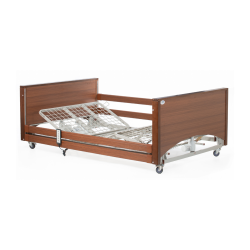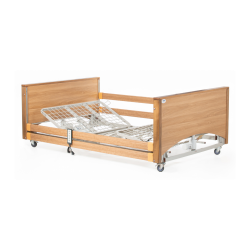Bariatric Profiling Beds
There are 2 products.
Active filters
About Bariatric Profiling Beds
Heavy-Duty Beds for Bariatric Patient Care
Bariatric profiling beds provide specialised heavy-duty adjustable sleeping surfaces designed specifically for patients with obesity across care homes, hospitals, bariatric care facilities, and specialist units throughout England, Scotland, Wales, and Northern Ireland. These robust care beds feature reinforced construction supporting significantly higher weight capacities than standard beds typically 300-500kg safe working load, wider sleeping surfaces accommodating larger body dimensions, and enhanced mechanisms withstanding increased forces. Healthcare environments utilise bariatric beds for patients undergoing bariatric surgery programmes, care home residents with obesity, hospital inpatients exceeding standard bed capacities, rehabilitation patients requiring robust equipment, and individuals requiring dignified appropriate accommodation. Modern bariatric profiling beds incorporate features including extra-wide platforms typically 1200-1400mm compared to standard 900mm, enhanced actuators providing reliable operation under increased loads, reinforced frames ensuring structural integrity, appropriate profiling functionality maintaining adjustment capabilities, and robust castors supporting mobility despite increased weight. The provision of bariatric profiling beds demonstrates commitment to size-inclusive care, prevents discrimination ensuring all patients receive appropriate equipment, supports patient dignity through suitable provision, and enables comprehensive care across weight spectrums throughout professional care environments.
The implementation of bariatric profiling beds directly supports CQC compliance through accessible patient care meeting equality requirements, patient safety through appropriately rated equipment, and demonstration of inclusive care provision. Patients with obesity attempting to use standard capacity beds face serious risks including bed structural failure potentially causing injury, inadequate width compromising comfort and positioning, reduced functionality from overloaded mechanisms, and dignity violations from inappropriate equipment. Bariatric beds address these challenges by providing appropriate weight capacity ensuring structural safety, accommodating body dimensions through wider sleeping surfaces, maintaining adjustment functionality through enhanced mechanisms, and supporting dignity through suitable equipment provision. Clinical applications include bariatric surgery care supporting pre-operative preparation and post-operative recovery, general hospital care for patients with obesity, care home provision for residents exceeding standard bed capacities, rehabilitation supporting mobility development, and critical care enabling comprehensive monitoring. Healthcare organisations benefit from bariatric beds through prevented equipment failures avoiding injury and cost, regulatory compliance meeting equality obligations, enhanced reputation as inclusive care providers, and comprehensive capability serving all patients. Modern bariatric beds incorporate features such as integrated scales, enhanced side rails, and specialised pressure-relieving surfaces throughout England, Scotland, Wales, and Northern Ireland.
Selecting and implementing bariatric profiling beds requires assessment of patient populations, appropriate specification, and integration with size-inclusive care strategies across healthcare facilities throughout the UK. Organisations should evaluate patient weights determining required bed capacity, assess body dimensions influencing width requirements, consider clinical needs including pressure care for patients with obesity, and calculate bed quantities based on bariatric patient prevalence. Bed selection should prioritise appropriate safe working load typically 300-500kg based on patient assessment, adequate width accommodating body dimensions typically 1200-1400mm, maintained profiling functionality ensuring adjustment capability, robust construction ensuring longevity under demanding use, and compatibility with bariatric pressure-relieving mattresses. Implementation protocols must encompass staff training on bariatric bed operation and patient handling, appropriate mattress selection, and sensitive communication about equipment provision. Quality assurance measures should include enhanced maintenance schedules reflecting increased mechanical demands, documented weight capacity checks, integration with bariatric care pathways, and monitoring of equipment-related incidents. Modern bariatric beds incorporate features such as enhanced motors, wider control handsets, and heavy-duty accessories. Organisations should establish protocols for bariatric bed allocation based on patient assessment, maintain adequate bariatric equipment complementing beds including hoists and commodes, and integrate with size-inclusive care policies. Staff education should address sensitive equipment provision communication, recognition of standard equipment limitations, and comprehensive bariatric care approaches. Environmental considerations should ensure adequate space around bariatric beds, doorway widths accommodating bed movement, and floor loading capacity. By implementing bariatric profiling beds and size-inclusive care protocols, healthcare organisations throughout England, Scotland, Wales, and Northern Ireland demonstrate their commitment to CQC standards, equality obligations ensuring inclusive care provision, patient safety through appropriately rated equipment, and comprehensive care capability enabling dignified, safe care for all patients regardless of size across care environments.


